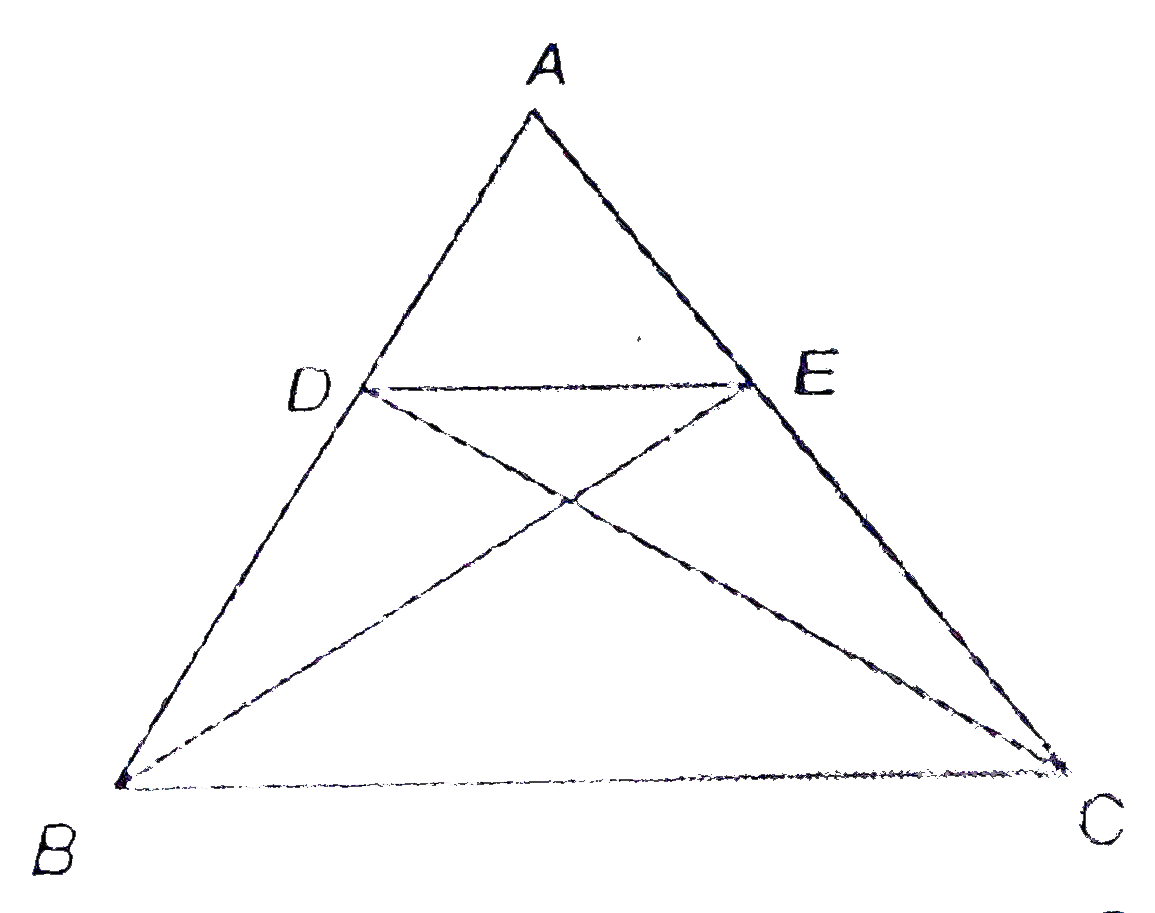Let ABC be a given triangle. Points D and E are on sides AB and AC respectively and point F is on line segment DE. Let ADAB=x,AEAC=y,DFDE=z. Let area of ΔBDF=Δ1, Area of ΔCEF=Δ2 and area of ΔABC=Δ.
Q. Δ2Δ is equal to :
(1−x)y(1−z)
(1−x)(1−y)z
x(1−y)(1−z)
(1−x)yz
The correct Answer is:C
To solve the problem, we need to find the ratio of the area of triangle CEF (denoted as Δ2) to the area of triangle ABC (denoted as Δ). Given the relationships between the segments of the triangle, we can use the properties of similar triangles and the area formula for triangles.
1. Understanding the Ratios:
We are given:
- ADAB=x
- AEAC=y
- DFDE=z
2. Area of Triangle ABC:
The area of triangle ABC can be expressed as:
Δ=12×AB×AC×sin(θ)
where θ is the angle at vertex A.
3. Finding Area of Triangle CEF:
The area of triangle CEF can be expressed in terms of the segments:
Δ2=12×CE×CF×sin(α)
where α is the angle at vertex C.
4. Using Ratios:
From the given ratios, we can express CE and CF in terms of x, y, and z:
- CE=(1−y)⋅AC
- CF=(1−z)⋅DE
5. Expressing DE:
Since DE can be expressed in terms of AB and AC:
DE=(1−x)⋅AB
6. Substituting Values:
Substitute CE and CF into the area formula for Δ2:
Δ2=12⋅(1−y)⋅AC⋅(1−z)⋅DE⋅sin(α)
7. Finding the Ratio:
Now we can find the ratio Δ2Δ:
Δ2Δ=(1−y)(1−z)⋅DE⋅sin(α)AB⋅AC⋅sin(θ)
8. Final Expression:
Using the relationships:
Δ2Δ=(ADAB)⋅(1−AEAC)⋅(1−DFDE)
We can substitute x, y, and z:
Δ2Δ=x⋅(1−y)⋅(1−z)
Final Answer:
Thus, the ratio Δ2Δ is equal to:
Δ2Δ=x⋅(1−y)⋅(1−z)
We are given:
- ADAB=x
- AEAC=y
- DFDE=z
The area of triangle ABC can be expressed as:
Δ=12×AB×AC×sin(θ)
where θ is the angle at vertex A.
The area of triangle CEF can be expressed in terms of the segments:
Δ2=12×CE×CF×sin(α)
where α is the angle at vertex C.
From the given ratios, we can express CE and CF in terms of x, y, and z:
- CE=(1−y)⋅AC
- CF=(1−z)⋅DE
Since DE can be expressed in terms of AB and AC:
DE=(1−x)⋅AB
Substitute CE and CF into the area formula for Δ2:
Δ2=12⋅(1−y)⋅AC⋅(1−z)⋅DE⋅sin(α)
Now we can find the ratio Δ2Δ:
Δ2Δ=(1−y)(1−z)⋅DE⋅sin(α)AB⋅AC⋅sin(θ)
Using the relationships:
Δ2Δ=(ADAB)⋅(1−AEAC)⋅(1−DFDE)
We can substitute x, y, and z:
Δ2Δ=x⋅(1−y)⋅(1−z)
Thus, the ratio Δ2Δ is equal to:
Δ2Δ=x⋅(1−y)⋅(1−z)
Topper's Solved these Questions
- SOLUTION OF TRIANGLESBOOK - VIKAS GUPTA (BLACK BOOK) ENGLISHCHAPTER - SOLUTION OF TRIANGLESEXERCISE - Exercise-4 : Matching Type Problems
2 Videos
- SOLUTION OF TRIANGLESBOOK - VIKAS GUPTA (BLACK BOOK) ENGLISHCHAPTER - SOLUTION OF TRIANGLESEXERCISE - Exercise-5 : Subjective Type Problems
11 Videos
- SOLUTION OF TRIANGLESBOOK - VIKAS GUPTA (BLACK BOOK) ENGLISHCHAPTER - SOLUTION OF TRIANGLESEXERCISE - Exercise-2 : One or More than One Answer is/are Correct
15 Videos
- SEQUENCE AND SERIES BOOK - VIKAS GUPTA (BLACK BOOK) ENGLISHCHAPTER - SEQUENCE AND SERIES EXERCISE - EXERCISE (SUBJECTIVE TYPE PROBLEMS)
21 Videos
- STRAIGHT LINES BOOK - VIKAS GUPTA (BLACK BOOK) ENGLISHCHAPTER - STRAIGHT LINES EXERCISE - Exercise-5 : Subjective Type Problems
10 Videos
Similar Questions
In the given triangle P, Q and R are the mid points of sides AB, BC and AC respectively. Prove that triangle PQR is similar to triangle ABC.

View SolutionLet ABC be a right triangle with length of side AB=3 and hyotenus AC=5. If D is a point on BC such that BDDC=ABAC, then AD is equal to
View SolutionIn ΔABC,D,E and F are mid-point of sides AB ,BC and AC respectively , Prove that AE and DF bisect each other.
View SolutionLet Δ denote the area of the ΔABCandΔp be the area of its pedal triangle. If Δ=kΔp, then k is equal to
View SolutionABC is a right triangle right-angled at B. Let D and E be any points on AB and BC respectively. Prove that AE2+CD2=AC2+DE2
View SolutionIn ΔABC,D and E are the points on sides AB and AC respectively.
Find whether DE || BC, if :
AB = 9 cm, AD = 4 cm, AE = 6 cm and EC = 7.5 cm.
View SolutionIn ΔABC,AB=AC.D,Eand F are mid-points of the sides BC, CA and AB respectively . Show that :
AD is perpendicular to EF.
View SolutionIn a triangle ABC , let P and Q be points on AB and AC respectively such that PQ∣∣BC . Prove that the median AD bisects PQ.
View SolutionABC is a triangle A line is drawn parallel to BC to meet AB and AC in D and E respectively. Prove that the median through A bisects DE.
View SolutionIn the adjoning figure, D and E are the points on the sides AB and AC respectively of ΔABC and area of ΔBCE= area of ΔBCD.
Prove that DE∣∣BC

View Solution
